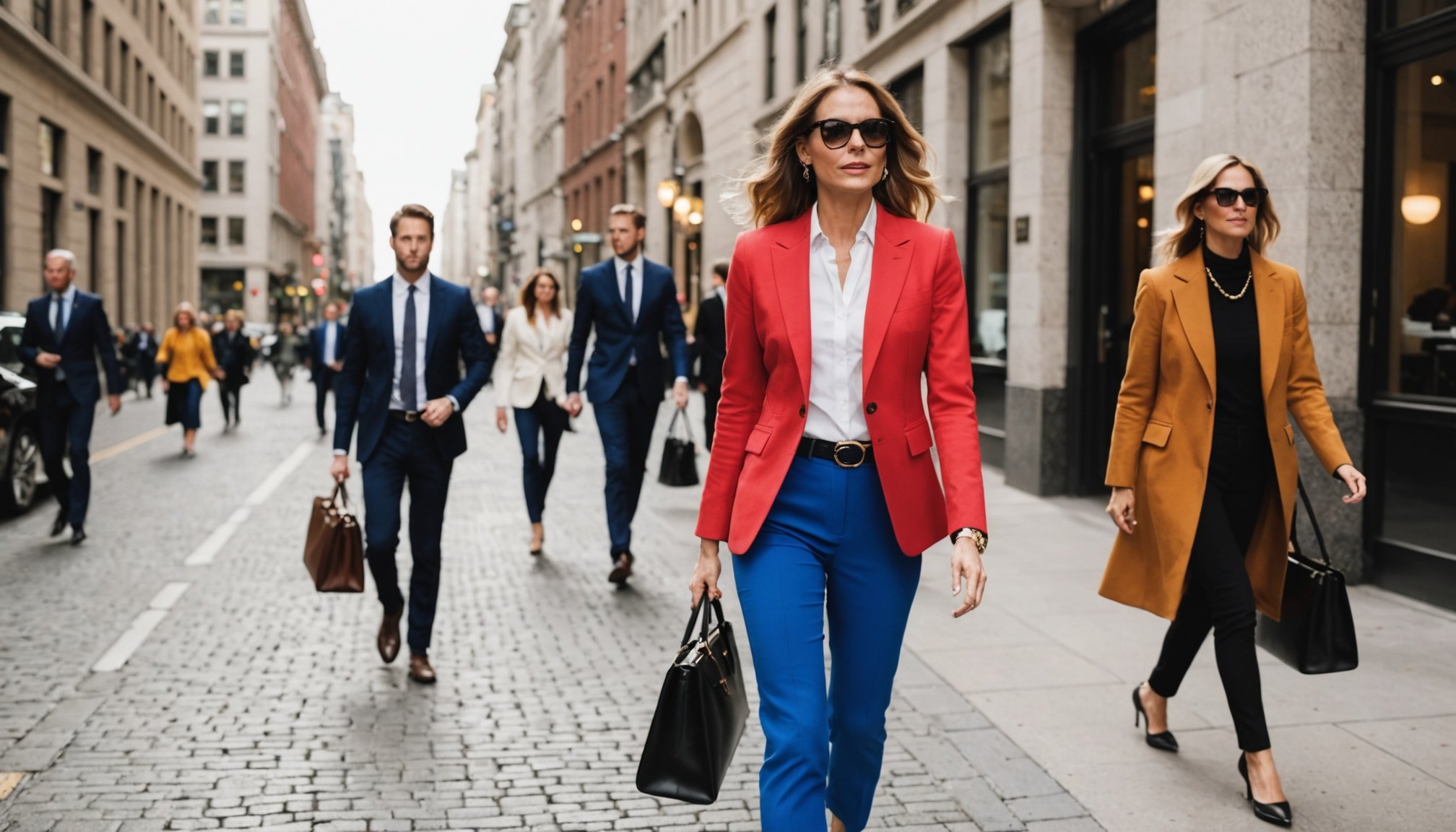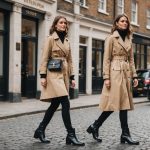Understanding Color Theory for Professional Attire
Color Theory profoundly influences how we dress professionally. At its core, it examines how colours interact and the emotional responses they evoke, playing a crucial role in Professional Dress. For instance, certain hues can exude power, while others foster calm—a strategic use in professional settings.
Emotional Impacts of Colors
Colors trigger psychological reactions. For example, blue often promotes trust and stability, ideal for conveying reliability. Red, in contrast, can be perceived as bold or aggressive, depending on its use. Leveraging Color Psychology to understand these emotional impacts helps in crafting professional attire that aligns with desired perceptions.
Also to see : Sustainable Style: Unveiling the Best Eco-Friendly Wool Sweaters for Your Cozy Autumn Wardrobe
Color Combinations that Convey Authority
Combining colors strategically can project authority and confidence. Dark suits with white shirts create a stark contrast that corroborates power and professionalism. Incorporating moderate accents, such as a subtle, authoritative tie, adds to this effect. A structured approach to color combinations not only projects confidence but also aligns with industry norms.
In summary, mastering Color Theory and understanding Color Psychology are indispensable for enhancing one’s professional presence. Knowing the emotional implications of colors enables one to make informed decisions that align with career goals and workplace culture.
Also read : Radiant Skin Mastery: Essential Tips for Retinol Success
Choosing the Right Colors for High-Stakes Meetings
Navigating the world of Outfit Coordination for high-stakes meetings can seem daunting, but Color Selection plays a key role. It begins with Analyzing Personal and Corporate Brand Colors to ensure attire reflects these values. This not only demonstrates alignment with the company ethos but can also heighten individual confidence.
Selecting colors for meetings involves understanding the context. For example, muted tones might be more appropriate for solemn discussions, whereas vibrant hues could complement creative brainstorming sessions. Meeting Attire should adapt to these environments, enhancing communication and collaboration.
Considering seasonal palettes lends an additional layer of thoughtfulness to color choices. Summer meetings might benefit from lighter, breathable tones, while winter calls for warmer, richer shades. These considerations ensure that your professional appearance remains sharp and relevant, attuned to any setting or time of year.
Integrating these strategies when choosing meeting attire allows professionals to project competence and presence. Remember, the right choice of colors not only boosts personal confidence but also helps you seamlessly fit into the broader narrative of your organisation, fostering trust and authority. By fine-tuning Color Selection, one can significantly enhance their professional image and effectiveness.
Effective Outfit Combinations for Confidence
Crafting stylish outfits that exude a confident appearance begins with outfit combinations that strike a balance between bold and neutral colors. Establishing this balance creates a professional look that commands respect. For instance, pairing a bold, patterned blouse with a neutral blazer can exhibit taste and authority. This approach allows each piece to accentuate the other without overwhelming your overall appearance.
Layering is another technique to enhance visual appeal. A thoughtfully chosen vest over a crisp shirt can add depth and texture, creating a more polished appearance. Layering techniques provide the versatility needed to adapt to various professional settings while maintaining a sophisticated look.
To bridge formality with personal style, mix-and-match core pieces like tailored trousers with a colourful light scarf or statement belt. Not only does this maintain professionalism, but it also adds a personal touch.
When composing outfit combinations, consider their practicality and impact. Evaluate how each piece complements others, ensuring they contribute positively to your confident appearance. Thoughtful selection and coordination of your wardrobe can significantly boost how you feel in a professional environment.
Accessorizing to Elevate Your Outfit
Accessories can drastically alter your professional style, playing a key role in elevating your overall appearance. Choosing accessories that complement your outfit’s colors is crucial. For instance, a tie or scarf that matches or contrasts tastefully with your attire can create a cohesive look. The expertise in selecting such items lies in their ability to both enhance your outfit coordination and subtly convey authority.
Choosing Accessories that Complement Your Colors
Ties, scarves, and jewellery offer diverse options to refine your appearance. A minimalist watch or subtle earrings maintain professionalism while adding a touch of sophistication. Choose accessories that highlight your outfit’s base colours or provide a pop of contrast for added visual interest.
The Role of Accessories in Professional Settings
Incorporating accessories can express unique personality traits while adhering to workplace norms. A carefully selected belt or pocket square can signify attention to detail and respect for professional attire standards, enhancing your presence.
Case Studies of Successful Accessorizing
Consider high-profile individuals known for their style. They often use accessories strategically—like a statement necklace or elegant cufflinks—to create a memorable yet professional impression. Such examples underscore the importance of thoughtful accessory choices within professional environments.
Practical Tips for Implementing the Color Code
Embracing the color code in professional attire calls for strategic planning and consistency. Daily outfit tips are invaluable for those seeking to present a polished image. Start by familiarising yourself with color swatches or digital applications capable of providing guidance in aligning your attire with the desired color psychology. These tools can help simplify the decision-making process, ensuring your attire reflects professional goals and color theory.
Before attending high-stakes meetings, prepare by pre-selecting outfits that match the occasion. This involves considering not only the formal requirements but the psychological subtext influenced by your color selection. Prompt preparation assists in reducing stress and guarantees you’re dressed appropriately and strategically.
Consider setting aside time weekly to evaluate your wardrobe in light of your dressing for success objectives. By spending a few moments contemplating your outfit choices, you align your appearance with the message you wish to convey. Adopting these strategies ensures your presence resonates with confidence and authority, leveraging the full potential of color psychology.
Implementing these methods will not only streamline your clothing choices but foster a sense of professionalism bound to impress colleagues and clients alike.
Visual References and Examples
Utilising visual outfits can greatly aid in understanding effective professional attire. Color combination tables offer convenient reference points, enabling professionals to quickly identify suitable color pairings that convey authority and confidence. These tables can feature combinations of neutral tones with accent pieces, simplifying the selection process and ensuring appropriateness for various professional contexts.
Real-life Examples from Professionals
Examining outfit examples from seasoned professionals offers valuable insights. Successful figures often employ a harmonious blend of classic colors and subtle pops of personality to maintain a polished image. By analysing these real-world applications, individuals can extract inspiration and apply similar strategies to their own professional visuals.
Before and After Transformations
Incorporating before and after transformations can dramatise the impact of thoughtful outfit coordination. These visual guides showcase the transformative power of aligning with color codes and demonstrate the elevation of one’s appearance through well-chosen attire. Such examples solidify the importance of visual coherence, highlighting how adjustments in color selection can lead to notable enhancements in professional presence and confidence.
Visual References and Examples
Utilising visual outfits can greatly assist in comprehending the effectiveness of professional attire. Color combination tables serve as convenient reference points, allowing professionals to swiftly identify suitable color pairings that exude authority and confidence. These tables can feature combinations of neutral tones with accent pieces, ensuring appropriateness for diverse professional contexts.
Color Combination Tables
These tables often present neutral tones as a base, complemented by accent colors for a dynamic impact. For instance, pairing a grey suit with a burgundy tie can project a balanced yet authoritative persona. Such combinations can streamline the selection process, aiding in constructing an outfit that harmonizes with both individual style and professional expectations.
Real-life Examples from Professionals
Examining outfit examples from seasoned professionals offers invaluable insights. Many successful figures employ a mix of classic colors and subtle personality pops to uphold a polished image. By analysing these real-world applications, individuals can draw inspiration, applying similar strategies to enhance their own professional visuals.
Before and After Transformations
Incorporating before and after transformations clearly showcases how aligning attire with colour codes can elevate one’s appearance. Visual guides highlight the impactful shift in professional presence and confidence, underscoring the importance of thoughtful outfit coordination.






